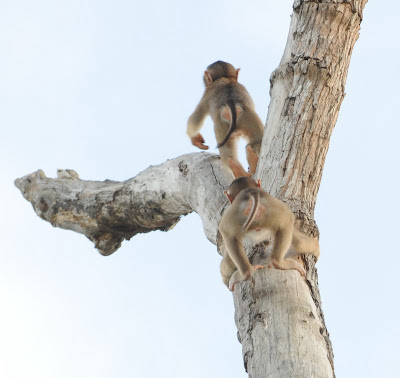The Kinabatangan is a good place for primate-watching. Ten species live in the riverine forest, making the area one of only two sites in Asia with such a rich diversity of primates. The list includes three leaf-eating langurs, two macaques and Borneo's most remarkable and unique primate, the Proboscis Monkey (Nasalis larvatus).
The Lower Kinabatangan is a particularly important site for the Proboscis; you can download a 1992 paper on their conservation in the area by I. Boonratana and D.S. Sharma here, and a more recent assessment by John Sha et al. here. For general information on primate behaviour and ecology you can check out the detailed factsheets at the University of Wisconsin's PrimateInfo site.
The Lower Kinabatangan is a particularly important site for the Proboscis; you can download a 1992 paper on their conservation in the area by I. Boonratana and D.S. Sharma here, and a more recent assessment by John Sha et al. here. For general information on primate behaviour and ecology you can check out the detailed factsheets at the University of Wisconsin's PrimateInfo site.
Along one of the tributaries we had a close encounter with a family group of Pig-tailed Macaques (Macaca nemestrina). Pig-tails associate in groups of up to 80 animals, but these break up into smaller subgroups like the one we encountered. They are very common in the area, and may have increased as the forests become more fragmented (although, unlike some other macaques, they seem to require at least some intact forest). According to Sha et al., pig-tails may be displacing proboscis monkeys in some areas as their populations grow.
A subgroup may have a number of males and females, but babies appear to be cared for by their mother alone. Care includes, of course. lots of grooming...
And, it seems, quite a bit of simple quality time.
Infants, though, seem quite willing to leave Mother for a scamper or a chase!
A subgroup may have a number of males and females, but babies appear to be cared for by their mother alone. Care includes, of course. lots of grooming...
And, it seems, quite a bit of simple quality time.
Infants, though, seem quite willing to leave Mother for a scamper or a chase!
Watching the pig-tails from the other side of the tributary was a Long-tailed Macaque (Macaca fascicularis). Long-tails and pig-tails do more than simply hang out together; they occasionally hybridize.
Few primates are as closely associated with water, both fresh and salt, as the Proboscis Monkey. Proboscis Monkeys are excellent swimmers; I have seen them plunge deliberately into the water from a considerable height. Though they range widely in the forest by day, according to Boonratana and Sharma they return to the riverside for the night. An early or late boat trip should pass most or all of the family groups in the area.
Family troops are common along the Kinabatangan. Each contains a harem of females, several young at various stages of growth, and one big old male with pot belly and full banana nose.
The pot belly is not a sign of obesity or poor shape. Proboscis are leaf eaters, and like all leaf-eating animals they need to eat a huge amount up get the nutrition they need, and a place to store their food while their intestinal flora disposes of the masses of cellulose that no animal can break down on its own.
The function of the remarkable nose is a bit tougher to explain, but it may act as a sound resonator (though there is apparently no clear evidence to support this). Adult males produce a remarkable and quite un-monkey-like honking noise. There is a nice piece of video, including calls, here.
This is, I admit, no more than a "record shot", but for me it was quite a record. It shows, in a distant tree on the main river, a mother Bornean Orangutan (Pongo pygmaeus).
Hoewver, the breakup of the forest into small patches as the oil palm plantations advance is a grave threat to the orangs, as they cannot cross from one patch to another to get food or seek shelter. What is needed - and what the Sabah government, working with NGOs and palm-oil producers, may at last be willing to provide, are reforested corridors bringing the patches back into contact. You can read about the problems, and the plans, here. I hope it happens - there is little time left.












No comments:
Post a Comment